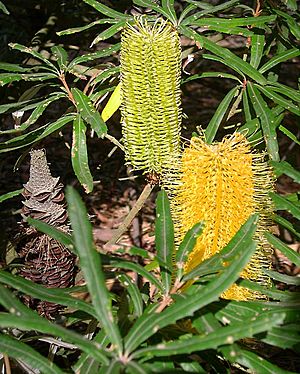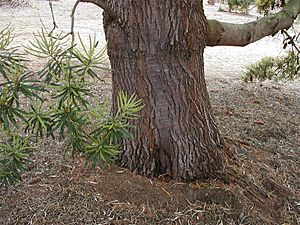River banksia facts for kids
Banksia seminuda, also known as the river banksia, is a type of tree that belongs to the Banksia group of plants. You can find it in the southwest part of Western Australia. It grows from a town called Dwellingup all the way to the Broke Inlet, which is east of Denmark.
For a long time, people thought the river banksia was just a different kind of Banksia littoralis, also known as the Swamp Banksia. But scientists later realized they were different enough to be their own species. One scientist, Stephen Hopper, even described a smaller, shrub-like version called remanens. However, another expert, Alex George, felt this smaller form was just a natural variation of the river banksia and not a separate type.
Quick facts for kids river banksia |
|
|---|---|
 |
|
| B.seminuda cultivated in Mount Barker, Western Australia |
|
| Scientific classification | |
| Kingdom: | |
| (unranked): | |
| (unranked): | |
| Order: | |
| Family: | |
| Genus: | |
| Subgenus: | |
| Section: | |
| Series: | |
| Species: |
B. seminuda
|
| Binomial name | |
| Banksia seminuda (A.S.George) Rye
|
|
Contents
What Does the River Banksia Look Like?
The river banksia usually grows as a tall tree. It can reach up to 25 metres (about 80 feet) high. Its trunk is often straight and tall, usually brown to grey. It has a tough, grey bark with deep grooves. This tree often grows in sheltered forest areas.
Leaves of the River Banksia
The leaves of the river banksia grow in circles around the stems. They are long and thin, measuring about 5 to 12 cm (2 to 4.7 inches) long. They are also about 1 to 1.8 cm (0.4 to 0.7 inches) wide. The edges of the leaves have small teeth, like a saw. The top side of the leaf is slightly furry, but it becomes smooth over time. The bottom side is covered in white fur.
Flowers and Fruits
The river banksia flowers from late summer to late winter. Its flower spikes are usually yellow, but sometimes they can be red. These spikes can grow up to 200 mm (about 8 inches) tall and 70 mm (about 3 inches) wide. After the flowers fall off, the tough, woody cones remain on the tree for many years.
How Scientists Classify the River Banksia
Scientists use a system called taxonomy to group and name living things. This helps them understand how different species are related.
Early Classification
The first official sample of Banksia seminuda was collected in 1973 by Alex George. In 1981, he described it as a type of B. littoralis. This was part of his big book about the Banksia genus.
However, in 1984, a botanist named Barbara Rye noticed something important. She saw that B. seminuda and B. littoralis did not mix or breed with each other. This was true even when they grew side-by-side and flowered at the same time. She also saw big differences in their bark and flower shapes. B. seminuda grew near rivers, while B. littoralis grew in wet, low areas. Because of these differences, she suggested they should be separate species.
Modern Classification
Later studies, including one in 1996 by Kevin Thiele and Pauline Ladiges, looked at the relationships between different Banksia species. They found that B. seminuda was closely related to B. littoralis and B. verticillata.
Here's a simplified way to see how B. seminuda fits into the Banksia family, according to Alex George's system:
- Banksia (The main group)
* B. spinulosa * B. ericifolia * B. verticillata * B. seminuda * B. littoralis * B. occidentalis * B. brownii
A study in 2013 used DNA to look at the relationships. It suggested that B. seminuda is a close relative to B. quercifolia and B. oreophila.
Different Forms of River Banksia
In 1989, Stephen Hopper described a special type of Banksia seminuda called subspecies remanens. These plants were usually shrubs, only 2–3 metres (6.5–10 feet) tall. They also had smaller leaves, about 4–6 cm (1.5–2.3 inches) long. You can find these shorter forms near the coast in Walpole-Nornalup National Park. However, Alex George believes these are just natural variations within the species, not a separate subspecies.
Where the River Banksia Grows
The river banksia lives along the edges of rivers and creeks. It grows in forests with Jarrah, Marri, and Karri trees. Its range stretches from Dwellingup to Denmark in Western Australia.
The shorter, shrubby form (subspecies remanens) grows in deep sand near granite rocks. This is mostly within the Walpole-Nornalup National Park. It grows among other plants like the mallee form of jarrah (Eucalyptus marginata), basket bush (Spyridium globulosum), and pineapple bush (Dasypogon bromeliifolius). It also grows with other banksias, such as bull banksia (Banksia grandis), oak-leaved banksia (B. quercifolia), and granite banksia (Banksia verticillata).
River Banksia and Its Environment
How it Survives Bushfires
The river banksia is killed by bushfire. However, it can grow back from its seeds after a fire. If the fire burns all the way around the trunk, the tree will die. These trees usually grow in areas that don't burn very often, mostly in summer and autumn. Young river banksia plants take about five years to start flowering after a fire.
Climate Change Impact
Scientists have studied how climate change might affect the river banksia. They found that the area where this tree can grow might shrink significantly. Its habitat could decrease by 30% to 80% by the year 2080, depending on how severe climate change becomes.
Growing River Banksia
The B. seminuda is a strong and adaptable plant. It can grow well in gardens. However, there have been reports of new seedlings growing from cultivated plants in other areas. This means people should be careful if they plant it near natural bushland, as it might spread.
- George, Alex S. (1981). "The Genus Banksia L.f. (Proteaceae)". Nuytsia 3 (3): 239–473.
- Taylor, Anne; Hopper, Stephen (1988). The Banksia Atlas (Australian Flora and Fauna Series Number 8). Canberra: Australian Government Publishing Service. ISBN 0-644-07124-9.
See also
 In Spanish: Banksia seminuda para niños
In Spanish: Banksia seminuda para niños



